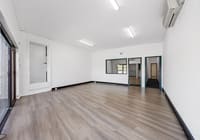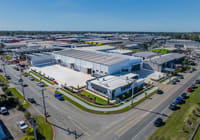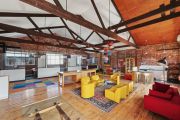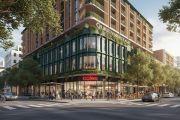
Co-working spaces back with a vengeance in work-from-home era
“Why not? Why not have a bowling alley?” That’s Cliff Ho, talking about his latest co-working space in Sydney’s CBD. The Commons, where Ho is chief executive, now has more than a dozen locations, marking a quiet comeback for co-working after years in the wilderness.
The remarkable rise of co-working in the 2010s was meant to revolutionise the way people did business, well before the coming of working from home. They were agile, creative and cheap – and spruiked by charismatic entrepreneurs like Adam Neumann, who founded WeWork.
By 2019, the dream was coming to an end. Neumann, the sector’s Svengali, crashed out in a haze of tequila, trying to smuggle a cereal box full of marijuana from Israel to the United States. WeWork, which had more than a dozen locations in Australia, limped along and went broke in 2023.
But companies such as Ho’s The Commons and Hub Australia, backed by Melbourne’s wealthy Smorgon family, are growing. The amount of office space now given over to co-working, or flexible, space has more than doubled in the past three years, from 7.2 per cent to 15.5 per cent, according to CBRE, one of the country’s largest commercial real estate agencies.
But co-working has changed, too. The competition isn’t the corporate office tower, it’s the kitchen bench, thanks to the surge in people working from home during the pandemic. That makes amenities more important, for a start. That’s why Ho has installed a bowling alley in an office space.
Lawson Hubbard, who specialises in office transactions at CBRE, says co-working spaces now have auditoriums and wellness facilities, not just the basic amenities such as bike racks and a tap that produces sparkling water.
“They [end-of-trip facilities] were a big thing 10 years ago. Now it’s just a core part of every single building,” he says. “I think disruption might not be the right word, but the industry is certainly undergoing a period of sort of substantial change, driven by demand for flexible spaces, amenities and more generally, a community-focused office experience.”
Part of the draw towards co-working is from businesses which have found their offices largely empty, even after a push to bring workers back from home. Many co-working spaces offer maximum flexibility – month-by-month subscriptions. If most people are still at home, it might make more sense to have a co-working space with 30 desks rather than a largely empty office with 100.
“You can call it right-sizing, maybe they’re sort of in this holding pattern where they might take a 30-person office with us,” Ho says. “They might have 50 employees, and they all have a pass, and they can rotate through.”
“What people are looking for within an office space is a strong sense of community to be coming in, and they want five-star hospitality. We’re adding in a lot more cafes, cocktail bars,” he adds.
“People want flexibility and autonomy. They don’t necessarily want to work from home or work from the office,” says Brad Krauskopf, the founder of The Hub, which is also backed by private credit firm Wingate.
“Inevitably, people are not coming in just to work. They want to be able to do some shopping, and they want to do entertainment or all those other things that come around the office experience, so the location is important.”
Four years ago, Alex Lambros was growing his mortgage-broking business Loan Market but didn’t want to commit to renting a shopfront. He wasn’t sure whether he would outgrow it, so he signed up with Wotso, one of the biggest co-working space operators which is now listed on the ASX.
He now employs three people, but says he is staying for several reasons.
“First would be the flexibility to help my business grow and contract. The second is that I don’t like working from home, and nor do my staff. They like having people around, the community,” Lambros says.
“It’s like water-cooler kind of stuff. You grab a glass of water and end up talking to someone. The people around me are a big bonus.”

But will this newfound interest in co-working spaces make for a bankable industry? WeWork collapsed early in the pandemic with losses nearing $US16 billion ($25 billion). But it had made losses for years, with filings ahead of a botched New York listing showing worsening finances even as the company quickly grew and brought new spaces into its portfolio.
Wotso, which has the most transparent accounts, made a pre-tax loss in the last financial year of $4.4 million even as earnings grew 14 per cent. Revenue from its co-working spaces – the company also owns a property portfolio – rose 6 per cent to $32 million, and it opened five sites.
But the company has told investors it expects to increase the amount of co-working space from 52,000 square metres to 72,800 by 2030. Revenue, it says, will rise to $58 million and earnings are on track to reach $15 million.
The Hub’s accounts are less clear. According to filings with the Australian Securities and Investments Commission, it recorded $64 million in revenue in the 12 months to the end of June 2024, up from $57 million. But enormous financing costs and depreciation meant it recorded a $33.7 million loss.
Meanwhile, monthly rents per desk are flat, according to information compiled by Rubberdesk, a popular booking service. In Sydney, they have hovered at about $1000 a month, per person, for almost 12 months. Some operators, says Rubberdesk chief executive Jim Groves, have been offering 50 per cent discounts for longer contracts to end the year at capacity.











